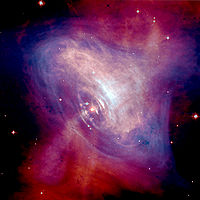Course:ASTR406/2023W
| High-Energy Astrophysics | |
|---|---|
 | |
| ASTR 406 | |
| Section: | 101 |
| Instructor: | Jeremy Heyl |
| Email: | heyl@phas.ubc.ca |
| Office: | Hennings 417 |
| Office Hours: | T 12:30pm-1:30pm |
| Class Schedule: | TTh 9:30am-11am |
| Classroom: | Hennings 301 |
| Important Course Pages | |
| Syllabus | |
| Lecture Notes | |
| Assignments | |
| Course Discussion | |
High-Energy Astrophysics
Much of astrophysics concerns the emission from relatively dense, thermal distributions of particles. High-energy astrophysics with a couple of exceptions is not. In particular high-energy astrophysics looks at emission from diffuse regions and regions where the particles have a significant non-thermal component; we shall see these two are connected.
Unit 1: Radiative processes (5 weeks)
- Relativistic electrodynamics
- Gas processes including fluid dynamics and shocks
- Radiative transfer
- Bremsstrahlung
- Synchrotron radiation
- Compton scattering
Unit 2: Compact objects (4 weeks)
- Polytropes and Lane-Emden equation; white dwarf structure
- White dwarf cooling
- Supernovae and supernova remnant evolution
- Neutron star structure and cooling
- Pulsars, magnetars, central compact objects, isolated neutron stars, etc.
- Black holes
Unit 3: Accretion power in astrophysics (3 weeks)
- Accretion-disk structure, Shakura-Sunyaev disks, temperature and luminosity predictions
- Spherical (Bondi-Hoyle) accretion
- Boundary layers, accretion onto magnetized neutron stars
- Observed accreting binary systems and comparison with theory
- Fireball model of Gamma-Ray Bursts
- Central engine of Gamma-Ray Bursts
Meeting Times
Class TTh 9:30am-10am Hennings 301 starting Sept 12 and ending Dec 7 (no class on Oct 12 and Nov 14)
Office Hours TTh 12:30pm-1:30pm Hennings 417
Final Exam 13 December 8:30am BUCH B313
Further reading
- The bulk of the lecture notes come from the monograph Astrophysical Processes.
- The classic book Black Holes, White Dwarfs and Neutron Stars by Stuart L. Shapiro and Saul A. Teukolsky.
- James Lattimer has prepared a detailed monograph on stars, stellar atmospheres, white dwarfs, neutron stars and black holes as well as the underlying physics (Unit 2): http://www.astro.sunysb.edu/lattimer/PHY521/phy521.ps PDF
- Henk Spruit has prepared excellent and very thorough notes on accretion disks with a focus on X-ray binaries and cataclysmic variables (Unit 3): http://arxiv.org/pdf/astro-ph/0003144v2.pdf
- Charles Dermer presented a nice series of lectures on gamma-ray bursts (Unit 3): https://arxiv.org/pdf/0809.3959.pdf
- Ed Brown created a monograph on stellar astrophysics: https://web.pa.msu.edu/people/ebrown/docs/stellar-notes.pdf
These links are mainly for you to get some different points of view to aid your learning. If you come up with some other useful links, I would be happy to add them here!
Learning Goals
As a result of taking this course you will be able to
- Explain fluid dynamics and shocks as applied to astrophysical gases
- Compute the expected amplitude and spectrum of emission for bremsstrahlung, synchrotron and Compton radiation
- Explain quantitatively the evolution of a supernova remnant
- Describe quantitatively the internal structure and cooling characteristics of white dwarfs and neutron stars
- Describe the various different observed types of neutron stars
- Describe Schwarzschild and Kerr black holes
- Explain quantitatively Bondi-Hoyle (spherical) and Shakura-Sunyaev (disk) accretion flows
- Compare the predictions of disk accretion theory, including the magnetized case, with observations of X-ray binary systems and accreting white dwarfs
- Explain quantitatively the leading model of gamma-ray bursts
Furthermore, you will learn to:
- Collect information supported by evidence, and analyze data
- Recognize when previous knowledge has to be re-evaluated as a result of new discoveries
- Fit newly gained information into a growing framework of understanding
- Develop well thought out and supported arguments
- Communicate effectively in a manner acceptable to the audience, in a variety of modes
- Collaborate effectively with other contributing participants in group work
- Manage projects and course work together with other commitments
- Reflect on your learning and how it relates beyond this course